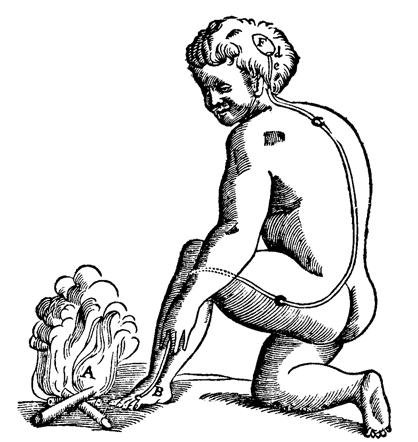What is pain?
To start this blog post, let’s dive into historical models of pain.
In the late 1500s, Rene Descartes was the first person to describe pain within the nervous system.
It was a very mechanical and SIMPLE model (see below) — a stimulus (see FIRE) activates a spot on the skin, which is attached to a nerve that travels up to the brain (think... a land line phone cord).
Descartes Model of Pain
Believe it or not, this simplistic model is STILL at the core of modern pain treatment!
Here are a few statements that are directly influenced by the Cartesian model:
1. Pain = damage, more pain = more damage
2. If you are in chronic pain, that must mean there is still damage in your body that is not healing
While we have to give him credit for realizing that pain is a nervous system feature, we now realize it is much more complex than that.
Pain is a response by the brain based on perceived threat. While this may seem similar to what Descartes described above, here is why it is different.
The old model puts emphasis on the threat, whereas the new model puts emphasis on the BRAIN. Let’s imagine two scenarios:
You are walking off of a curb and roll your ankle, immediately feeling pain.
You are walking off a curb and roll your ankle, but see a bus heading right for you. Odds are, you do not feel the pain of rolling your ankle.
Our new model begins to capture the complexity of pain as seen in scenario two.
There are inputs that travel up your spinal cord, to your brain. Those inputs include everything happening in your environment, whether it’s the tissue threat (what we call nociception), stress, fear, anxiety, etc.
Your brain then processes all of the inputs and decides what is most important to output.
In scenario number two, pain was not the most important output, instead, it was “Get out of the way!!!”
We now also know that there are strong correlations between a pain experience and fear. There’s a common phrase in neuroscience, “neurons that fire together, wire together.”
Let’s return to our scenarios above. In scenario one, the neuropathways related to the movement of stepping off of the curb were accompanied by the neuropathways of the pain experience. This new fear of stepping off of a curb can elicit a pain response with no tissue damage. It is learned pain.
Biopsychosocial Model of Pain
Now, we can imagine someone in chronic pain. They hurt their back 2 years ago picking up a box from the floor, and haven’t felt the same since. They have avoided bending over, and they associate that movement with pain. The good news is that any injury to their back is likely healed. The bad news is, this matters very little to the person since they are still in pain. So why are they still experiencing pain?
We have maps in our brains related to sensation and movement. For example, there are designated brain areas for the touch sensation of our lower back and another for the movement of it. These maps are designed by our environment and our experience, think “use it or lose it”. When we avoid movements that hurt, we “lose it” and that brain area is modified. This is a concept called cortical smudging. This idea is thought to enhance our pain experience. This movement is no longer represented by its previous brain area and is seen as a threat.
Sensory and Motor Homunculus (aka our brain maps mentioned above)
How can we modify our experience if there’s no tissue damage that needs to heal?
We slowly reintroduce movement and teach the brain that there is no threat involved with the movement.
We reshape our mindset towards that movement. We learn these concepts behind pain (called Pain Neuroscience Education) so we can begin to dissociate from the idea that pain = damage or harm, and that movement = future damage.
Big Takeaways
1. A 400 year old, simplistic model of pain still has heavy influence in medicine and society.
2. Pain is COMPLEX. It is influenced by input from our tissues AND environment.
3. The brain is the ultimate processor. It receives many, many inputs and decides what is most important to output.
4. Persistent pain alters your brain’s sensory and motor maps. It makes the maps “blurry” or “smudged”.
5. How do we fix #4? We MOVE and we LEARN.


